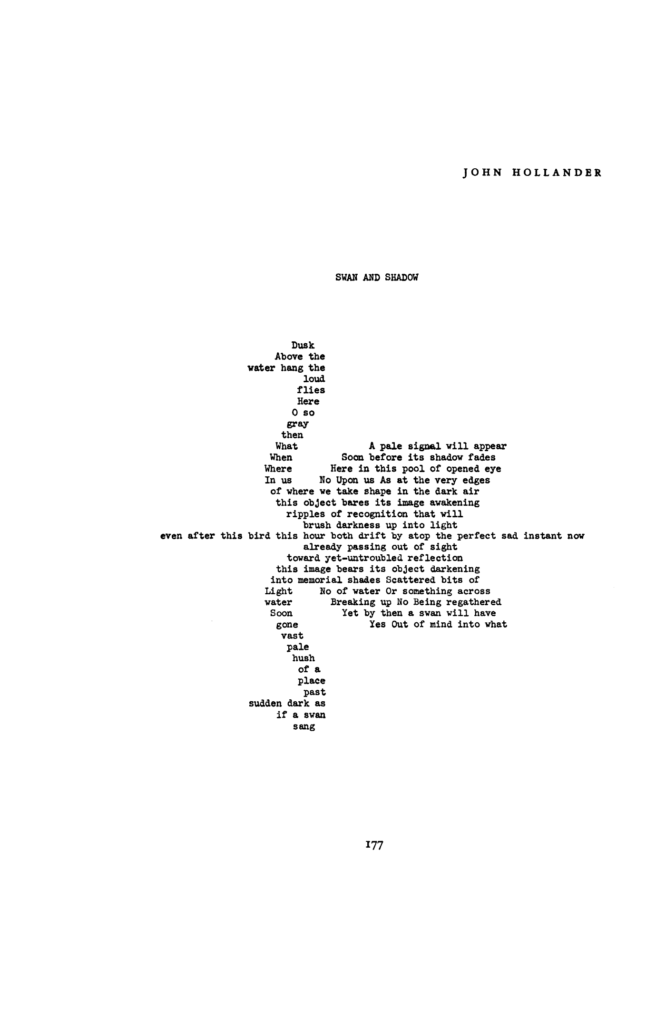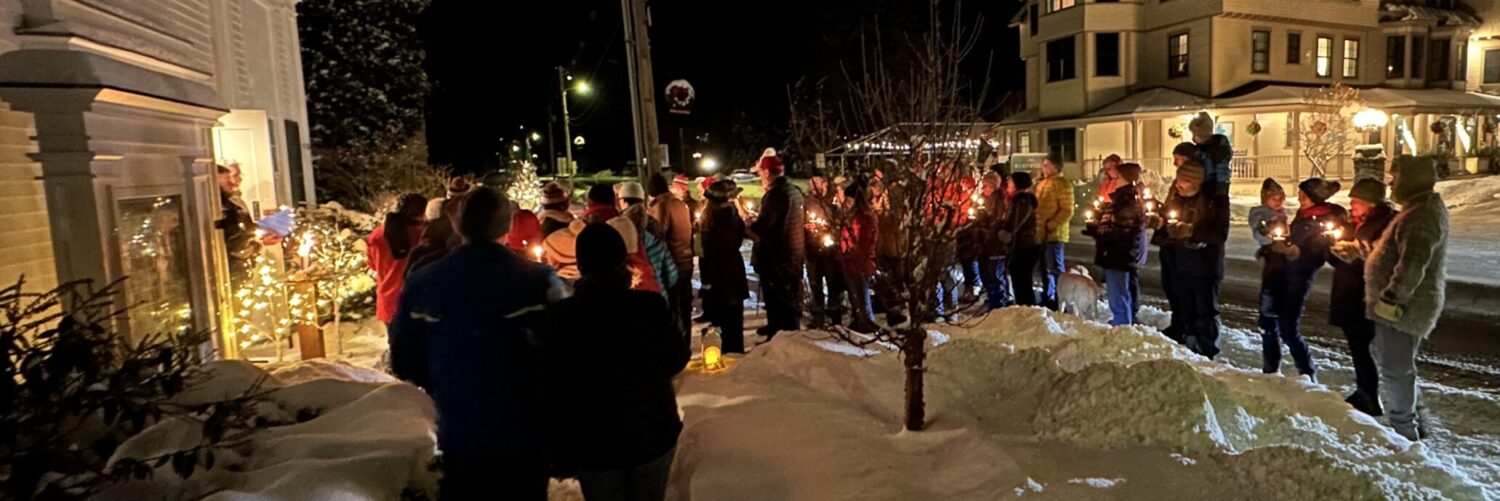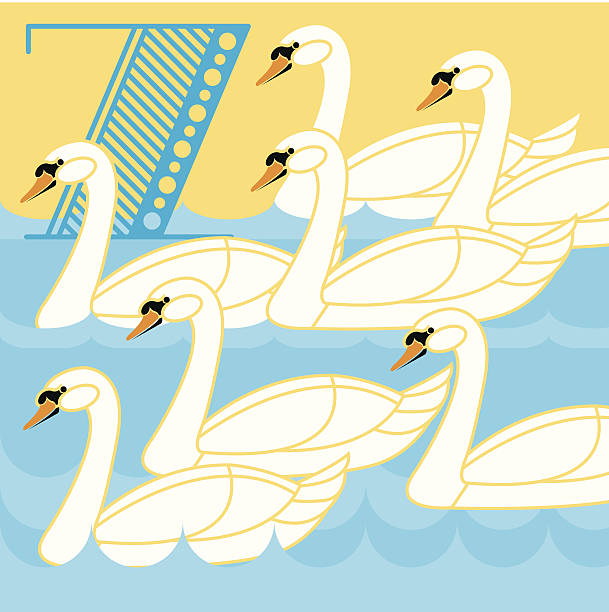Father, Where Do the Wild Swans Go? (excerpt)— Ludvig Holstein Father, where do the wild swans go?
Far, far. Ceaselessly winging,
Their necks outstraining, they haste them singing
Far, far. Whither, none may know.

SONGS about SWANS:
- 12 Days of Christmas by Twister Sister (heavy metal): https://youtu.be/LpYhYztj4R0
- Swan Song by Dua Lipa (pop): https://youtu.be/kO8fTk6oKQg
- Swan Lake performed by London Philharmonic Orchestra by Tchaikovsky: https://youtu.be/9cNQFB0TDfY
- Dance of the Little Swans by Tchaikovsky (ballet): https://youtu.be/Xd2nTXsivHs
- Blue Swan by James Giles (country?): https://youtu.be/Wm8aUguDrqo
- Secret Story of the Swan by IzOne (pop): https://youtu.be/fXSXUKXuqu8
- The Bonny Seans by LoreenaMcCennnitt (folk/Irish): https://youtu.be/JsNJuhBfbPg
- Swan Song by Lana Del Ray (movie score): https://youtu.be/dVvSDzWYM7E
- Black Swan by BTS (pop): https://youtu.be/0lapF4DQPKQ
- Black Swan / Odile Variation with Zakharova, Osipova, Nunez (ballet and orchestra): https://youtu.be/sYIHjStEQrk
- The Black Swan Dance (Odile’s Coda) (ballet – movie score): https://youtu.be/EqrRVKJcN7I
- Forget the Swan by Dinosaur Jr (rock): https://youtu.be/rFspexYC9p8Swan Lake
SYMBOLISM THEORIES: Seven Swans
As you will recall—for by now it’s an ear worm that you can’t stop humming—the 12 days begin on Christams Day with the partridge. On 5 or 6 of the following days, the gifts are birds, interrupted musically, thematically and enigmatically by those 5 golden rings… There have also been many Christian interpretations of this song but really no evidence to support any of them. I find the secular interpretations to be far more interesting and valid.
In the 237 years since the rhyme was first published in English, there have been at least 20 different versions of the words, especially with respect to the birds. Some of these variants are undoubtedly Mondegreens, but they were often probably just attempts to make the words more relevant to a contemporary audience…
The birds of days 6 and 7—the geese and the swans—round out the culinary theme before the song turns to dance providing some exercise after all that feasting, and chores that may have been neglected. — Robert Montgomerie, American Ornithology, full article: https://americanornithology.org/four-calling-birds/
The Seven Swans a Swimming verse represents the seven gifts of the Holy Spirit (Romans 12:6-8). Prophesy, service, teaching, encouraging, giving, leadership & mercy. Children were taught that when you walk with God the gifts of the Spirit moved in your life as easily as a swan on the water.— Hampshire Pewter
Seven Swans — Brownielocks, full article: https://www.brownielocks.com/twelvedaysofchristmas.html
Because many water-fowl could both fly and swim, the ancients had a real fascination with them. Many believed that these animals had a connection between natural and supernatural worlds. The migrations of some birds (disappearing when days grew short and coming when they grew longer) also added to their beliefs. Egypt Linked swans with immortality, just like they did the geese. The Greek priests, who worship Demeter, the goddess of agriculture, are believed to be descended from swans. Old Celtic and British myths believe that lost loved ones turn into swans, with gold or silver chains on their necks to symbolize their enchantment. The transformation is believed to take place during their Samhain festival, where the gates of the other worlds open up and souls are free to pass.
King Edward of England, in 1304 took his vows of knighthood over two white swans decorated with gold nets and crowns. Since then, the swans became associated with royalty; and, having swans was strictly exclusive to the monarchy. In Britain today, the swan is still considered a symbol of royalty.
In 1697 black swans were discovered in Australia. This caused a great stir in Europe, because up until then, it was believed that swans were suppose to be white. At least, they were all white in Europe!
Seven Swans A-Swimming — Revkev43, full article: https://revkev43.wordpress.com/2011/12/31/seven-swans-a-swimming/
Few of God’s creatures are more graceful than a swan floating on the water. These majestic animals have always been associated with royalty. In fact, even to this day, all swans in England that are not marked by an owner belong to the crown. Throughout history, kings have given swans away as gifts. A gift of seven swans would be extremely generous.
“On the seventh day of Christmas my True Love gave to me, seven Swans A-Swimming…”
If the “True Love” in this famous song represents God, the King, what do the seven swans filled with grace and beauty represent? They represent the seven gifts of grace (or grace-gifts, or spiritual gifts) mentioned in Romans 12:6-8. These seven gifts are often referred to as “motivational gifts” or “creation gifts” and are supernatural endowments given to believers for purpose of serving God and serving each other. When followers of Jesus receive their gift, recognize their gift, exercise their gift, and grow in their gift, the body of Christ swims effortlessly and gracefully across the waters, drawing others to Jesus. All believers have received a grace gift. Sadly, many believers have never opened their gift to see what is inside.
Below are seven short definitions of the seven gifts of grace (“Swans A-Swimming”) mentioned in Romans 12:6-8…
- Prophecy – The supernatural ability to expose sin by proclaiming God’s truth, righteousness, and warning of judgment to come. (The office gift of the prophet mentioned in Ephesians 4:11, and the manifestation of the gift of prophecy mentioned in 1 Corinthians 12:10, go beyond this simple definition of the motivational gift of prophecy.)
- Serving – The supernatural ability to meet practical needs, giving practical assistance wherever needed, becoming the hands and feet of Christ.
- Teaching – The supernatural ability to clarify truth through in-depth bible study, and a deep desire to share what has been learned with others.
- Encouraging – The supernatural ability to stimulate faith in others by giving counsel and guidance, helping others apply the Bible to their lives.
- Giving – The supernatural ability to give generously (above the tithe) to tangible needs, and the supernatural ability to give generously (above the tithe) helping to support the ministries of the church.
- Leadership – The supernatural ability to give oversight to the church, organizing ministries, achieving immediate goals of the group, enabling the church to run smoothly.
- Showing Mercy – The supernatural ability to relieve embarrassment by reaching out to others, having concern for the precise and varying feelings of individuals with a readiness to meet their needs.
Seven Swans A-Swimming — Julz, ful article: https://julzcrafts.com/2018/01/05/the-twelve-days-of-christmas-last-part-7-swans-a-swimming-all-the-rest/
Swans are one of the most charismatic birds. Their graceful flight and peaceful beauty as they glide across the water have inspired humans to find spiritual meaning in them. Iron Age Britons, eighth century BC and later, considered them supernatural. Mute swans are the traditional birds of folklore. Although migratory, they became semi-domesticated in Britain by the 10th century.
Richard the Lionhearted is often credited with bringing swans to England on his return from the Crusades in the 12th century, but some documentation shows swans being kept as far back as 966, during the reign of King Edgar.
It was in the 12th century that the Crown claimed ownership of all swans. In the 15th century, swan ownership was shared with the Vintners’ and Dyers’ Companies. That continues today, with an annual ceremony called Swan Upping, in which cygnets, baby swans, are captured, weighed, checked for health problems, banded and released.
So, the 12 Days of Christmas meaning behind Seven Swans-A-Swimming would have had royal as well as spiritual connotations.
In the 17th century, Mute Swans were semi-domesticated in England. In the Netherlands, they were farmed, for their down, their meat and as ornamental birds, according to Sylvia Bruce Wilmore, in her book, Swans of the World. In the Netherlands, those practices continued until after World War II. Because all swans in England belong officially to the Royal Family, swans given as gifts would have been marked on the upper part of their bills. Their markings identified the person who had responsibility for them and thus could benefit from them. Marks date back to 1370.
Today in the U.S., migratory waterfowl are protected by state and federal laws. Permits are required to keep wild birds legally. If you are in any doubt about birds you are considering acquiring, check with the state department of fish and game, parks and wildlife or natural resources.
STORIES about SWANS — Professor Kate Williams, full article: https://unireadinghistory.com/2019/12/19/twelve-days-of-christmas-seven-swans-a-swimming/
Seven swans a swimming – well, with giving this, our ‘true love’ was really buying us something rather expensive. Swans have always been luxury goods, a medieval Gucci handbag, if you will. In the medieval period, swans were status symbols, exchanged between noblemen as the centuries wore on, they became increasingly exclusive to royalty. Any top feast worth its salt had to have a swan as a centrepiece, especially at Christmas feasts. Ideally, you’d roast a few swans in their feathers and put a burning piece of incense in its beak. In 1251, Henry III ordered 125 swans for the Christmas feast for his court. Dining with the King in winter meant eating swan. Swans were so important to aristocratic and royal status that they had to be marked, usually on the soft skin of the beak. Notches would usually be cut in, but there could also be initials or even heraldic devices. These ‘swan marks’ became the property of the government; they had to be bought at great expense and, following the law that only wealthy landowners could own swans, their use was restricted. Essentially, from the late fifteenth century, only the Crown, the very rich and some wealthy institutions such as guilds, universities and cathedrals were lucky enough to have their own flock of swans. Any spare swans wandering around were automatically seen as the Crown’s – and picked up by Swan Collectors. Swanmoots were special courts to discuss ownership of swans. As you see, Swans were terribly sought after and often stolen.
In Horace Walpole’s astonishing collection of books at Strawberry Hill, were two books of ‘Swan Marks’, on vellum, probably dating from the sixteenth century. Still, now, we have the annual Swan Upping ceremony on the Thames in early July, when the ‘Swan Uppers’ of the Queen and two guilds, Vintners and Dyers, travel the Thames to count the swans.
Swans looked fabulous and denoted wealth and power, particularly on private estates. Whether the swan was worth eating was another question. One rather disgruntled commentator in 1738 complained that goose was much better – swan was ‘blacker, harder, and tougher’ and was hard on the digestion as well as having ‘melancholic juice’…but ‘for its Rarity serves as a Dish to adorn great Men’s tables at Feasts and Entertainments, being else no desirable Dainty’.[1] Indeed, full grown Swan was deemed so unappealing that baby cygnets were taken and bred separately in a fenced pen, fed on barley, purely so they’d be tastier to eat. When Christmas was restored after Charles II came to the throne, people’s minds turned to Christmas and the earliest Christmas menu – a huge feast of meat – lists a ‘swan pie’ along with ‘powdered goose’ and ‘six eels, three larded’. The Empress Josephine created a grand garden at her estate at Napoleon, a tribute to him, a claim of the glories of Napoleon, who was vaunted as taking anything from anywhere. She had a menagerie of foreign animals, including emus, kangaroos and an orangutan who ate carrots at the table with her guests. But her prize was her black swans, brought over from an expedition to map the coast of Australia from 1800-1803 – a prelude to empire. Over 200,00 specimens of plants were taken to the Museum of Natural History and Josephine got the animals, packed up in pairs and fed on water and bits of fruit on the way, including her beloved pair of black swans. Some of the animals died, but the swans settled in their pond on the outskirts of Paris. Josephine adored the swans and saw them as her symbol even on chairs!
The ‘Swan Song’ phrase comes from the notion, dating back to Aristotle and Socrates, that the swan sings better when it is nearing death. The Victorians were still eating swan, but it gradually fell out of fashion and now, of course, swans are protected. Until as late as 1998, killing a swan (that was not marked as your own) was still an act of treason. Now, it is simply illegal because they are protected. So, unfortunately, when your true love gives you seven swans, you probably should give them back. Along with everything else – the milkmaids, the dancing ladies and all of rest of it, as humans as gifts doesn’t really cut it anymore. But I think you can keep the geese …
12 days a (wildlife) Christmas – Seven swans a-swimming, full article: https://www.suffolkwildlifetrust.org/blog/lucy-shepherd/12-days-wildlife-christmas-seven-swans-swimming
Swans are one of our much loved birds and we are graced with three different species in the UK, mute, whooper and Bewick’s swan. Although easily identified as swans, telling them apart can be easier said than done. Mute swans help us out with an easily identifiable orange beak that has a black mass on top near the bird’s forehead, known as a knob, which is where mute swans get their other, perhaps less preferable name, of a knob swan from. Another way to tell them apart is that mute swans stay in the UK all year round with whooper and Bewick’s swans journeying huge distances to their summer breeding grounds near the arctic, so time of year might offer a helping hand.
Telling the difference between whooper swans and Bewick’s swans is where it gets a litter trickier. Although they both have yellow beaks, Bewick’s swans are much shorter than a whooper swan and their necks are straighter too. Another handy hint to help tell the difference is looking at the amount of yellow that the swans have on their beaks. The flatter slope of a whooper swan creates a triangle of yellow and is said to look like a wedge of cheese, with Bewick’s swans having more of a rounded curved beak, thought to be similar to a knob of butter. Sorry if these identifiable features have now made stomachs rumble.
Many years ago, swans were very valuable and receiving seven swans as told by our 12 days of Christmas song, would have been quite the Christmas treat. Swans were traded between nobility and owners of mute swans, the Vintners and Dyers were duty bound to mark them, with all unmarked swans being the Crown’s by default.
First started in the 12th century and a process that still continues today, mute swans were marked in a process called “swan-upping” carried out by the Queen’s Head Swan Master, (what a fantastic job title to have). Today, “swan-upping” is used as a conservation tool helping keep track of population numbers and allowing individuals to be monitored and health checks carried out. Since swan-upping began, only twice in its history has the census had to take a hiatus, once in 2012 due to extremely high water levels and this year due to COVID-19.
So this winter whilst you’re out on your walks this winter, why not have a look to see if you can find any swans and see if you are able to spot those triangles of cheese or knobs of butter on beaks and tell the difference between our swan species.
The Wild Swans at Coole — William Butler Yeats
The trees are in their autumn beauty,
The woodland paths are dry,
Under the October twilight the water
Mirrors a still sky;
Upon the brimming water among the stones
Are nine-and-fifty swans.
The nineteenth autumn has come upon me
Since I first made my count;
I saw, before I had well finished,
All suddenly mount
And scatter wheeling in great broken rings
Upon their clamorous wings.
I have looked upon those brilliant creatures,
And now my heart is sore.
All’s changed since I, hearing at twilight,
The first time on this shore,
The bell-beat of their wings above my head,
Trod with a lighter tread.
Unwearied still, lover by lover,
They paddle in the cold
Companionable streams or climb the air;
Their hearts have not grown old;
Passion or conquest, wander where they will,
Attend upon them still.
But now they drift on the still water,
Mysterious, beautiful;
Among what rushes will they build,
By what lake’s edge or pool
Delight men’s eyes when I awake some day
To find they have flown away?

